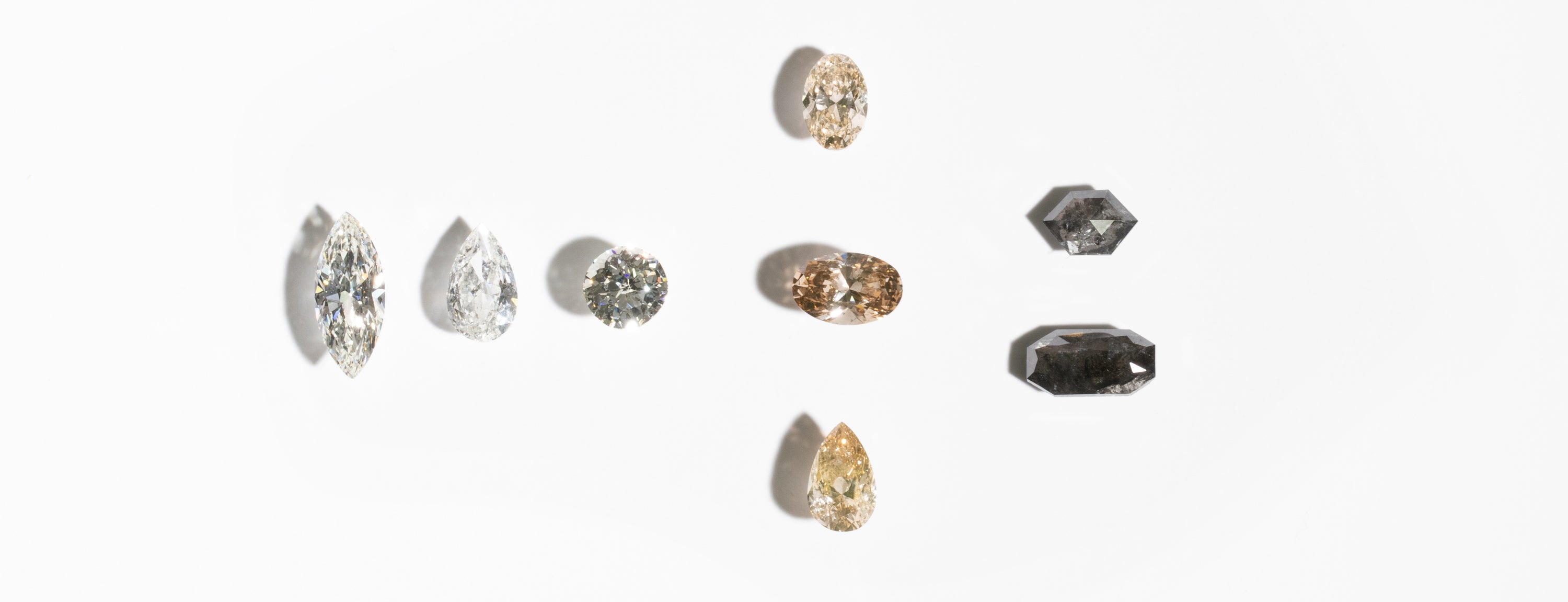
OUR GEMSTONES
NATURAL DIAMONDS
It has taken our team years of dedicated effort to find transparent sources for our natural diamonds. We are committed to disclosing all available information about each stone we work with.
Depending on the variety and size, stones may come with a certification. These certifications are created by a gemological lab that studies the stone’s clarity, cut, color, and carat. Diamond certification does not include provenance and it is rarely provided for smaller stones or champagne diamonds. Most diamond certificates come from GIA.
We make every effort to ascertain as much information as possible about our diamonds, however details are not always available. One solution to this common problem is working with post consumer recycled diamonds. See below to learn more.
Natural diamonds can be treated to “improve” their visual characteristics. None of our natural diamonds are treated with the exception of black diamonds. These beautiful stones are derived from highly included diamonds, heated to graphitize the fractures, transforming them into a glorious, opaque black.
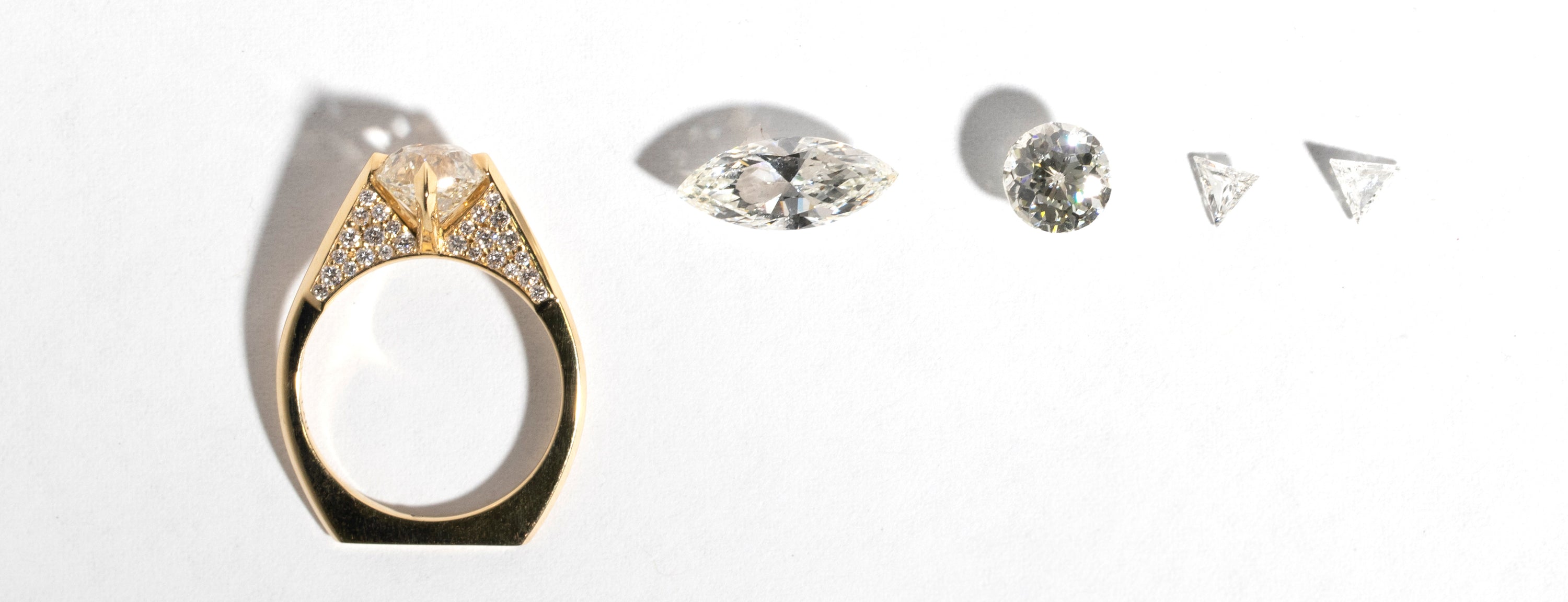

RECYCLED/POST CONSUMER DIAMONDS
The life of a diamond spans generations. Heirloom stones passed down to celebrate joyous occasions are infused with history.
Recycled diamonds (AKA reclaimed or post-consumer diamonds) are a low-impact, environmentally responsible alternative to virgin or newly mined stones. These stones come in a variety of cuts from Modern and Traditional to Old Miners or Old European; each cut has its own story.
We source our recycled diamonds from certified vendors; most are purchased from estate sales or directly from owners, then carefully extracted from their settings.
We are excited to be working with the first diamond cut recognized by GIA specifically created for reclaimed diamonds. The Crown Jubilee® is a unique cut created to revive reclaimed antique and vintage stones. Only one cutter in the world is able to skillfully rework these stones, respecting the original shape and highlighting its historical beauty. The Crown Jubilee® is table-less, with floral facets that come to a peak at the center of the diamond allowing light to remain in the stone longer; reflecting and refracting to increase sparkle and brilliance. Available in round and cushion shapes, each with a GIA certification.
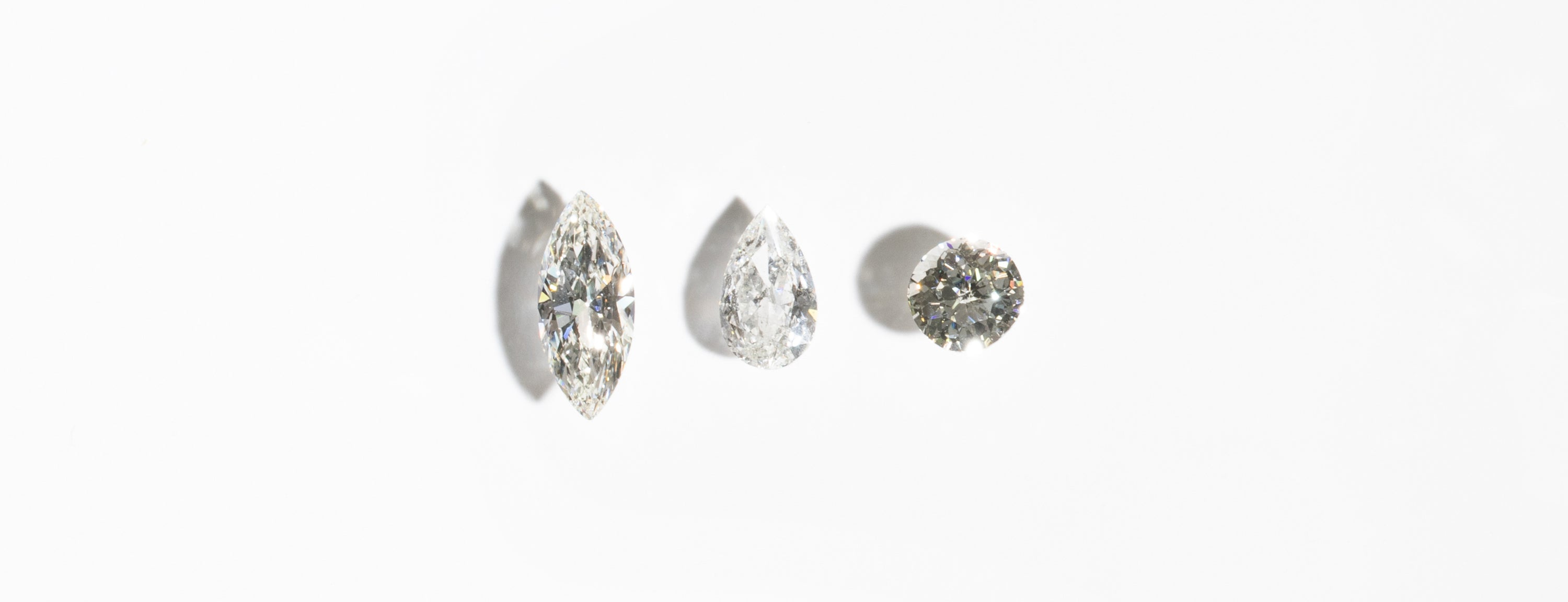

LAB GROWN DIAMONDS
For those who seek an alternative to mined stones, lab grown diamonds are created with the same properties, and they look, feel and sparkle just as natural diamonds. What has taken billions of years to develop, can now take as little as three weeks to grow using modern technology.
We utilize SCS Certified lab diamonds, the highest in ethical and environmental standards.
Lab Grown Diamonds Q & A:
Are these diamonds more ethical than natural diamonds?
Not all diamonds are unethical, in fact many options exist for natural, ethical diamonds. We offer the Crown Jubilee Diamond®; a recycled, repurposed diamond. Lab grown diamonds are not mined, however the process to create them in a lab does take a considerable amount of energy (carbon footprint metrics are not yet available). We have opened the conversation with our vendors about carbon footprint and hope that we will help to initiate more transparency.
Why would I choose a lab grown diamond over a natural diamond?
We see lab grown diamonds as a compliment to the Global change in perspective around sustainability. It’s a lovely option for those who are passionate about advances in the latest technology. Lab grown diamonds offer a lighter price point than natural stones, eliminate concerns related to mining, and in most cases offer a known source.
Can I use lab grown diamonds as pave?
Pave, or the industry term melee are the tiny diamonds used on our acute ring to add a textural element to our designs. As of 2019, we are able to make our rings using pave white lab grown diamonds. This is a custom option, please email us for specific requests.
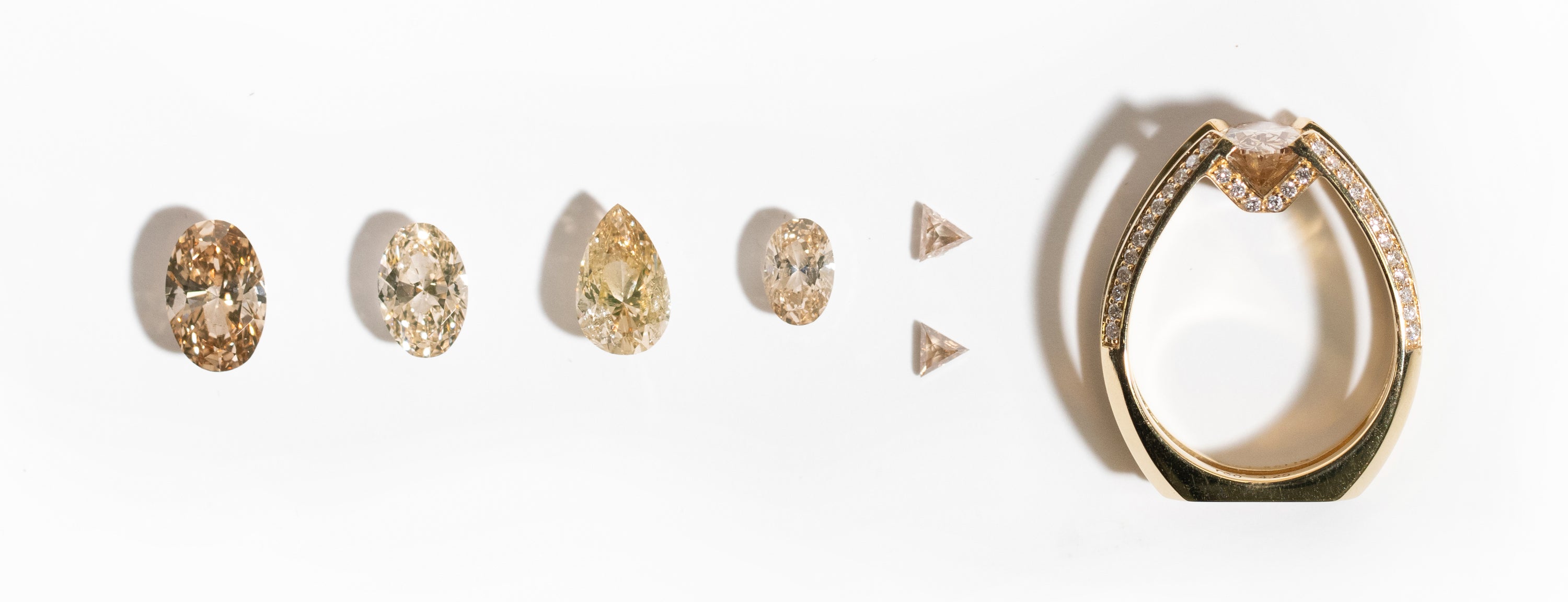

CHAMPAGNE DIAMONDS
We source most of our natural champagne diamonds from Australia, which are then cut in India. Champagne diamonds receive their color from traces of other elements living within the crystal structure; small amounts of nitrogen trapped during their formation millions of years ago cause the stone to have a beautiful, light champagne hue. Most champagne diamonds do not come with a certification unless they are of a large size and high clarity.
Champagne diamonds have a wide range of color from light to deep brown. Our preference is in the C1-C2 lighter Champagne tonality with a slight pinkish hue that brings a softness to the color and allows it to be beautifully set in either a gold or platinum/white gold setting.
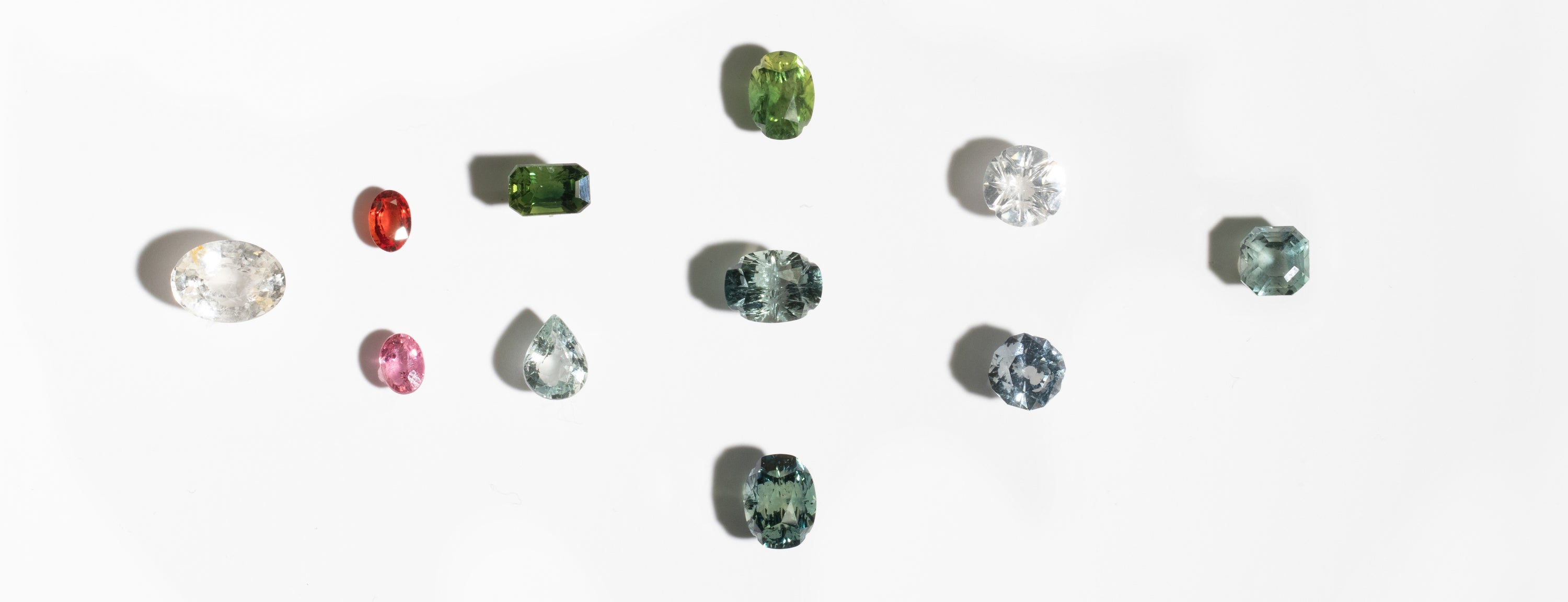
SAPPHIRES
Sapphires are made to last a lifetime, and at Bliss Lau, we love a sapphire. They are high on the hardness scale (right next to diamonds) and are therefore perfectly safe for daily wear. The sapphire’s strength is only matched by its vibrant spectrum of colors. Although Yves Klein Blue is the most famous, we stock sapphires in pale blue and green, bright light blues, orange, peach, yellow and more. Each of these stones is one of a kind.
Traditionally sapphire lore tells us the stone represents nobility, truth, sincerity, and faithfulness. Ancient and Medieval civilizations alike believed sapphires could cure illness; the Persians believed they were made from the elixir of immortality.
Sapphires often contain natural Inclusions within the stone, we believe this shows the character of their formation in the earth. A common inclusion you may see is known as Silk. We see this silk as beautiful, however Sapphires can be lightly heated to dissolve the silk, allowing the stone to become brighter and often, the color more saturated. Heated sapphires are still considered natural sapphires and retain their value.
Below we explain the sources of our Sapphires as well as their color ranges.


MONTANA SAPPHIRES
During the American gold rush of the 1860’s Montana became known as the ‘Treasure State’. At that time, gold miners came across small stones that were initially believed to be diamonds. In fact, what they had discovered were small sapphires.
Most of our stones come from the El Dorado Bar, a sapphire and gold mine located in Lewis and Clark County, Montana. From 1938-1944, an industrial gold mining operation was on this land. We have developed a close relationship with the miner who, by sifting with water, is able to extract these stones with little environmental impact. We have an extensive selection of stones ranging from half carat to two carats or more. Large Montana sapphires are quite rare, therefore each stone above two carats is a treasure.
Montana sapphires are known to have a silvery sheen, adding to their character. Most of the stones we stock are unheated* and live within the paler spectrum of color such as light blue, green, yellow and lavender. Occasionally these sapphires are ‘color change’ and able to transition between lavender in incandescent light and blue or green in sunlight. In some cases we offer lightly heated stones, which have a more vibrant color.
*Heating is a common process used to enhance color and clarity.
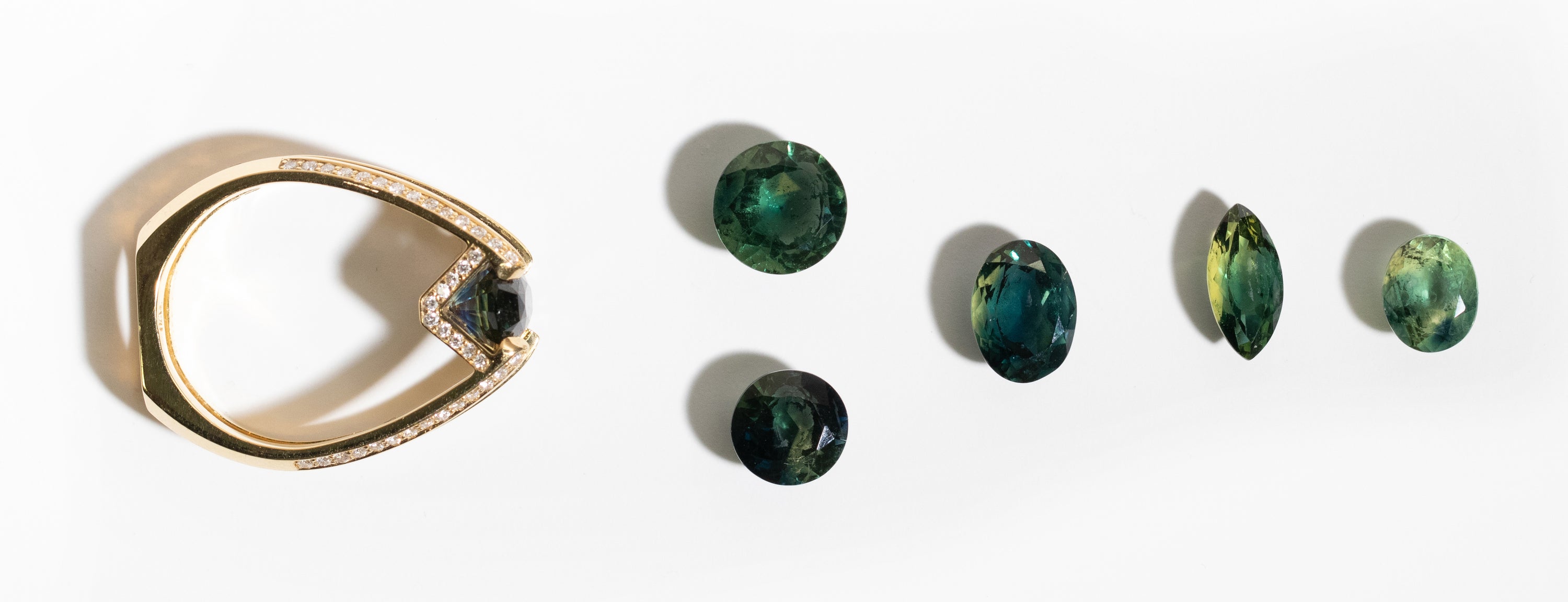

PARTI SAPPHIRES
Parti Sapphires host a trifecta of deep saturated color, tints of green, blue and yellow. These colors flash within the stone depending on the angle, and they are consistent in any light. This unique color zoning cannot be replicated in a lab, so you can be assured of the stone's authenticity. Each of these stones is one of a kind.
Beyond their beauty, all of our Partis are unheated, finely cut, and respectfully mined in Queensland, Australia. Most of our stones are oval; however, we do come across the occasional round and marquise shape. Due to our direct connection with the source, we are able to request custom sizes and colorations. Email us for specific requests.
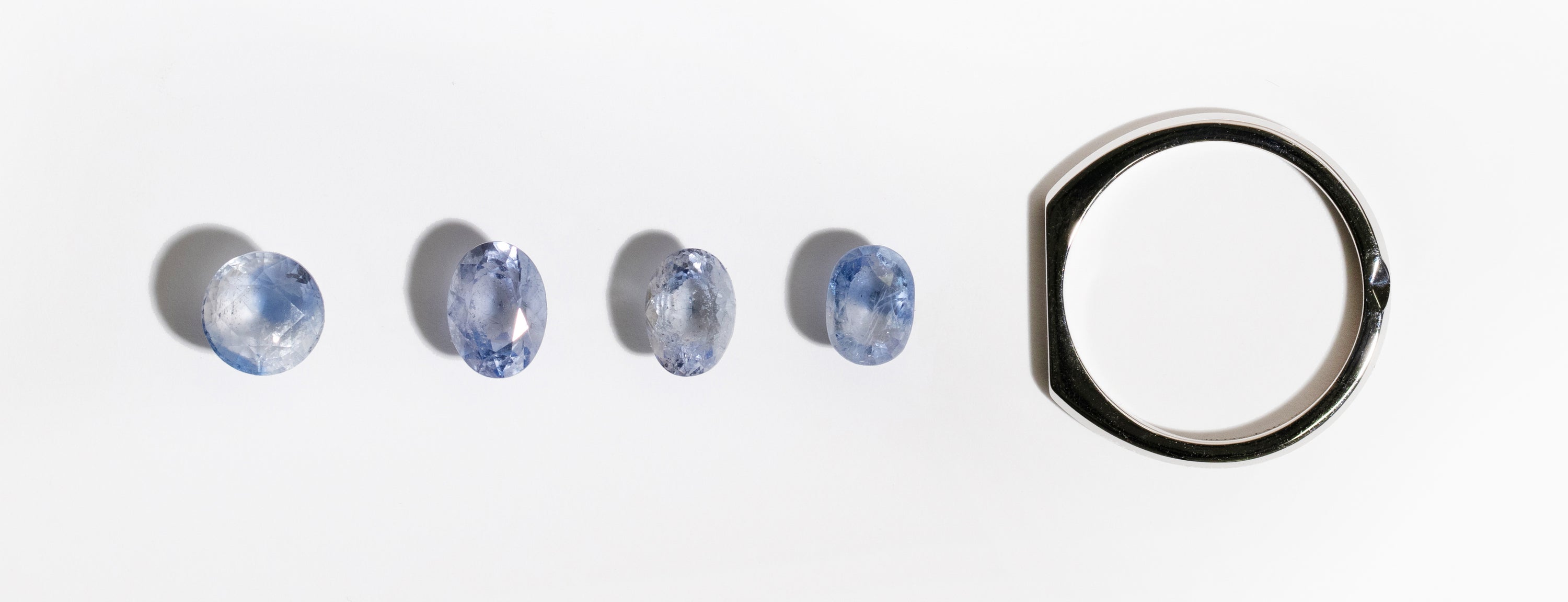

CEYLON SAPPHIRES
Ceylon Sapphires are only found in Sri Lanka, a reference to Sri Lanka’s previous name, which was changed in 1972. The name Ceylon is only given to those stones which hold a magical sky-blue coloration.
Also known as Gem Island, many of the stones mined in Sri Lanka are over 500 million years old. Sri Lanka’s historic gem industry is home to many generational stonecutters also known as lapidary artists. Beyond just Ceylon stones, many of our Sapphires are sent here for cutting.
The most sought after Ceylon coloration is even throughout, although we have stones with flashes of blue with white. We love these alternative stones. Ceylon Sapphires are mostly found in round, oval and cushion shapes.
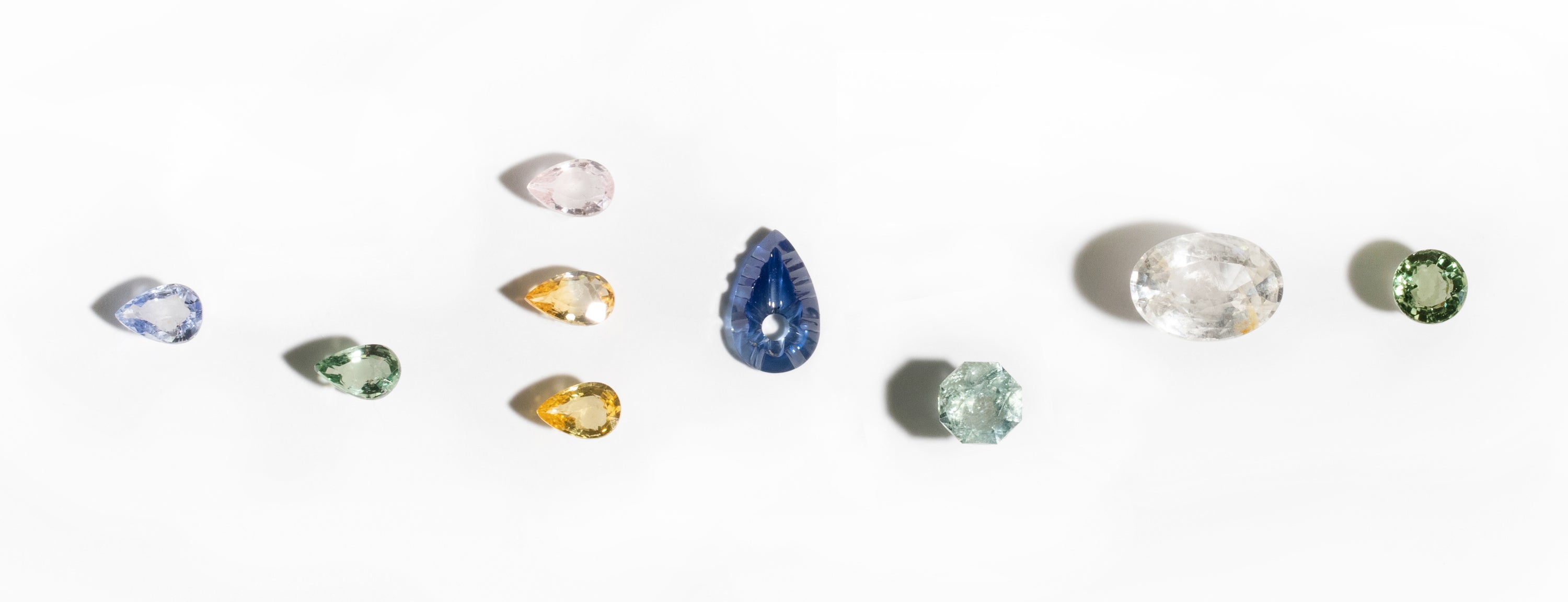

OLD STOCK SAPPHIRES
On our journey of sourcing, we often meet vendors who have ‘old stock.’ Generally, these are collections of stones that have been living in a vault for one to two decades or more. Gemstone color desirability moves in trends, and for many years, colors like green and pale sapphires were out of fashion. We see beauty outside of the norm, and for that reason, these alternative colors always catch our eye.
Part of our ethical model is to use readily available stones or those that are responsibly mined. Old stock, due to their previously dormant state, represents an opportunity for sustainability. In some cases, we know the provenance of old stock items, and we will always inform you if this information is available.
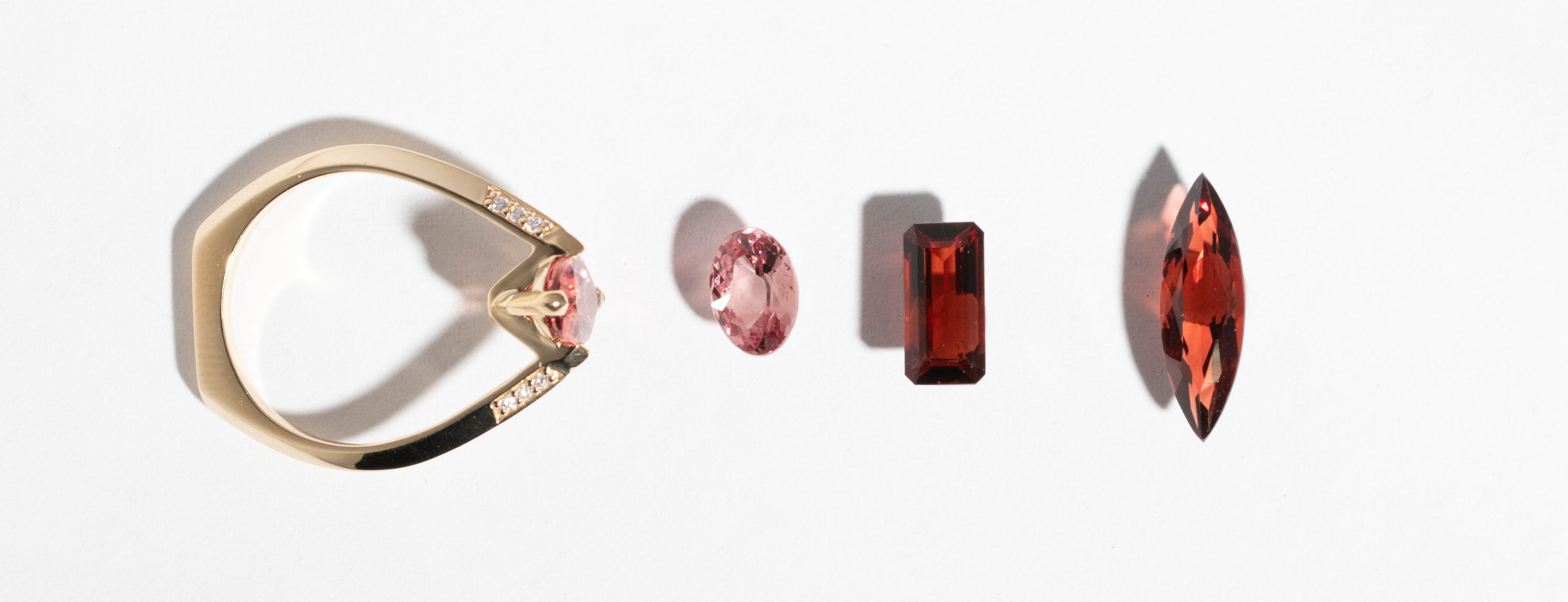
GARNETS
The name Garnet is derived from the latin word for pomegranate, granatum. It is a fitting reference for the deep, crimson color of these stones first worn by the ancient Egyptians. The red variety we use are said to be stones of attraction and sexuality, able to magnetize a lover and enhance charisma. Bliss wears a Rhodolite Garnet as her engagement ring stone.
Garnets come in a variety of colors from vibrant scarlet and lighter coral to mandarine orange and green. One of the many beautiful things about garnets is that they are not enhanced with heat; their color is always natural and pure. We use two variations of garnets in the Mirage Reflection Ring.
Garnets are suitable for daily wear on rings, earrings, necklaces and other jewelry pieces. Our garnets are sourced from Thailand, Madagascar and Mozambique.
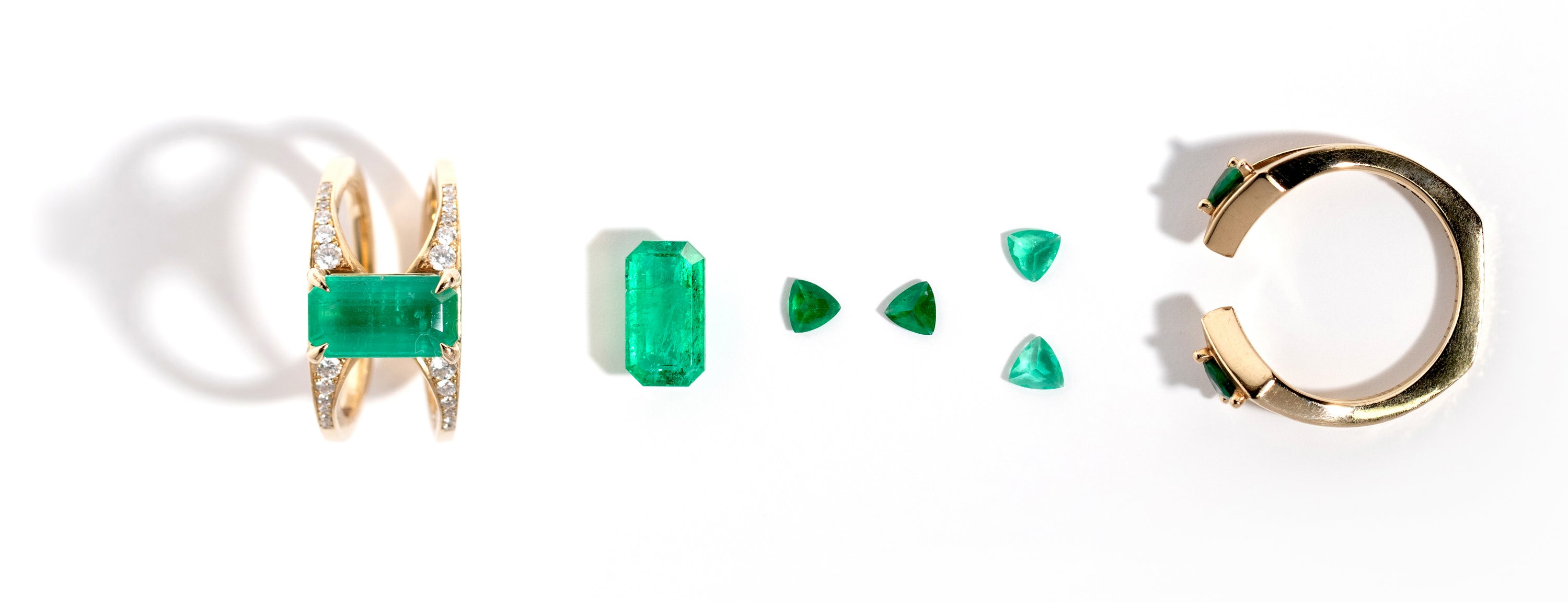
EMERALDS
The vibrant, green emerald has inspired and enchanted since the time of the Egyptians. In ancient times, it was believed to be a powerful talisman and able reveal the true intentions of a lover.
Compared to diamonds and sapphires, emeralds are soft, porous and famous for having multiple inclusions. Jewelers call these inclusions the jardin because they often resemble a garden within the stone. These inclusions cause the stone to be more delicate and we recommend all emeralds be worn with care.
Often emeralds are treated with natural oils. This practice is very common and is used to enhance the look of the stone, making it more bright. We always ask that our suppliers disclose any treatments on their stones
Our emeralds come from a variety of places. Colombian emeralds are prized and live at the top of the value scale, followed by Brazilian emeralds and Zambian emeralds. We have begun our Transparency Review process with our Colombian and Brazilian suppliers. At the moment we are seeking a clean supplier for Zambian emeralds.
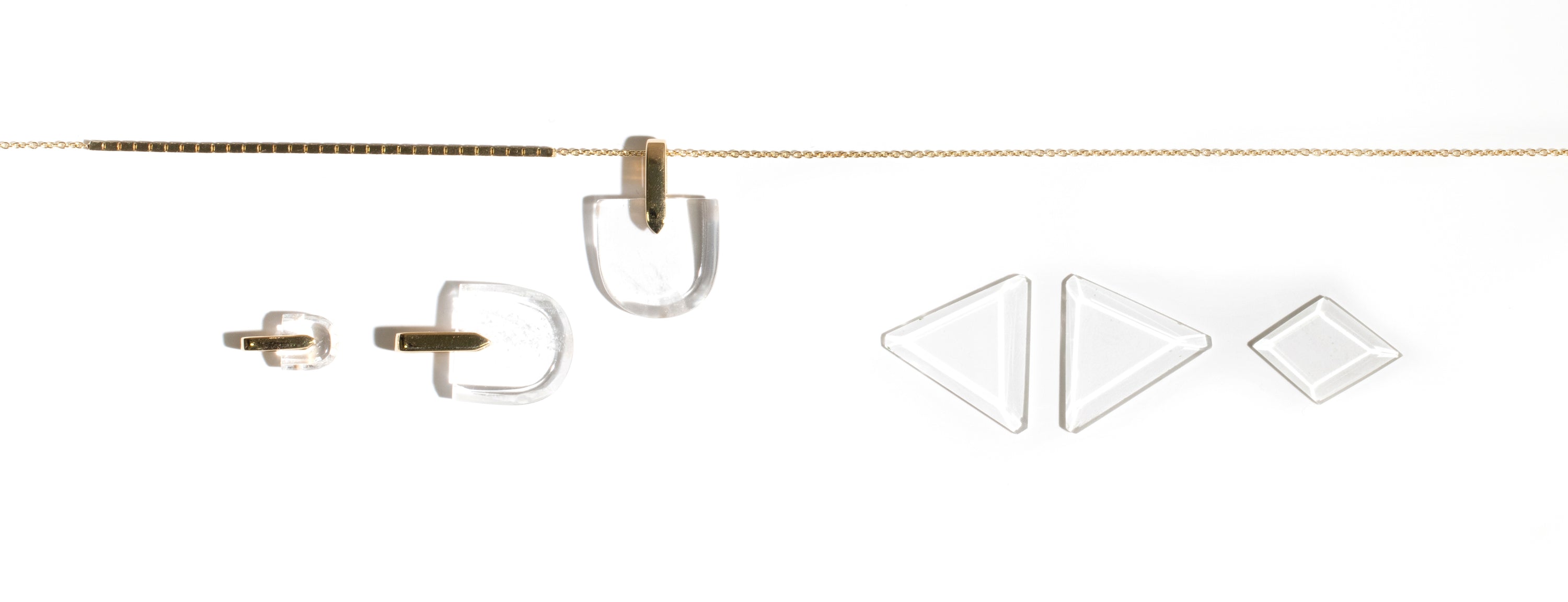
CRYSTAL QUARTZ
Quartz comes from the Greek word for ice; the Greeks believed that it was petrified ice from the gods, unable to melt. One of the most mystical stones, gemstone lore tells us of its ‘elixir’ qualities. Many believe it to be a generator that charges them with the energy of the sun or moon.
Crystal Quartz is also said to absorb the energy of the wearer, which is why we chose this stone for our Brevity Pendant. During her pregnancy, Bliss wore the Brevity Pendant with the intention of absorbing some of the growing energy during the birth process, encapsulating this magical moment in her life. She now wears the necklace to remember that special time.
We source our crystal quartz from Arkansas; pieces are then custom cut in Asia in a fair trade factory in Shenzen, China.
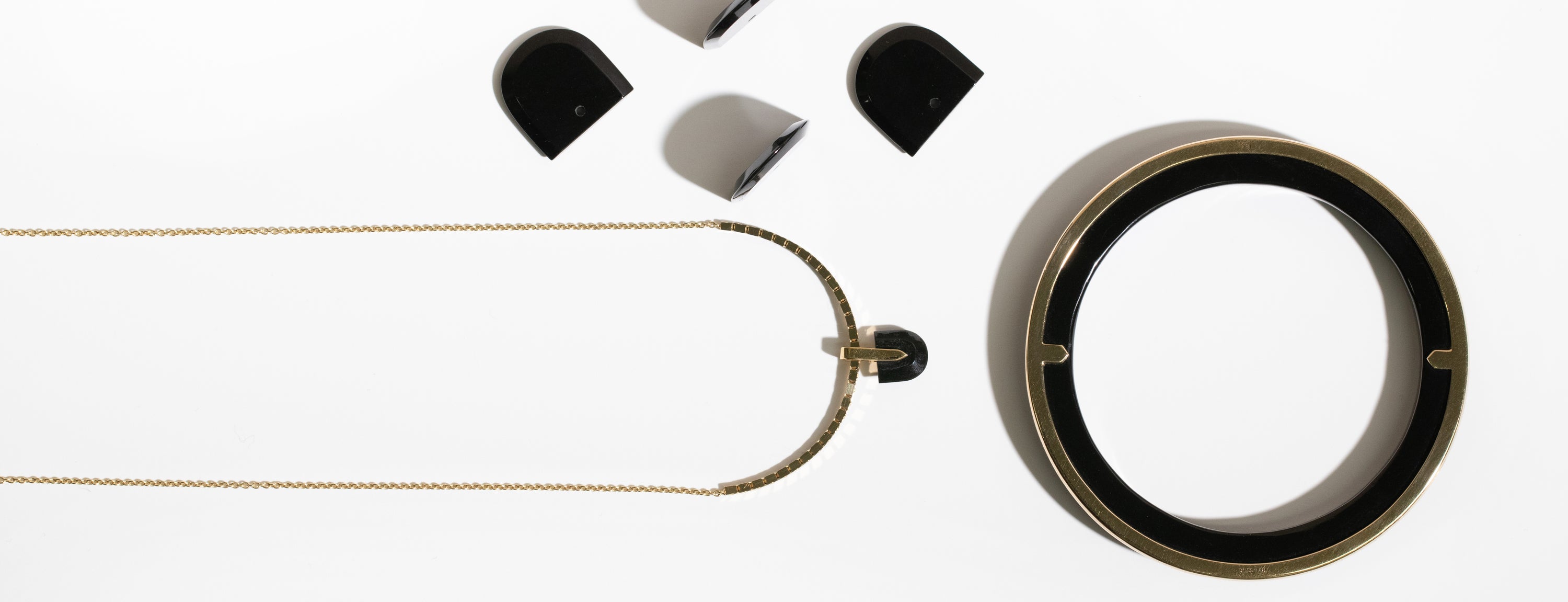
BLACK JADE
“Gold has a price, Jade is priceless.” - Chinese Proverb
Jade has been venerated in Asia since the Stone Age. In Chinese lore it is known as the ‘Stone of Heaven’. Ancient cultures believed jade to have medicinal qualities, and black jade in particular is known as the ‘bodyguard’ when worn. A stone of purification, it promotes honesty to oneself and is believed to make one invisible from people projecting anger or aggression.
Jade resonates deeply with Bliss. In homage to her Chinese heritage, she uses black jade in the Brevity Bracelet. Bliss has inherited several heirloom jade bracelets from members of her family, some of which were worn daily for over forty years — a testament to the strength and resiliency of this stone.
Jade has been mined in Asia since the Stone Age. It is an exceptionally tough stone and comes in two varieties, nephrite and jadeite. The black Jade we use is nephrite and comes from Australia. Some of our black jade was non invasively topically mined, and some is old stock mined in the 70’s, both are cut in China.
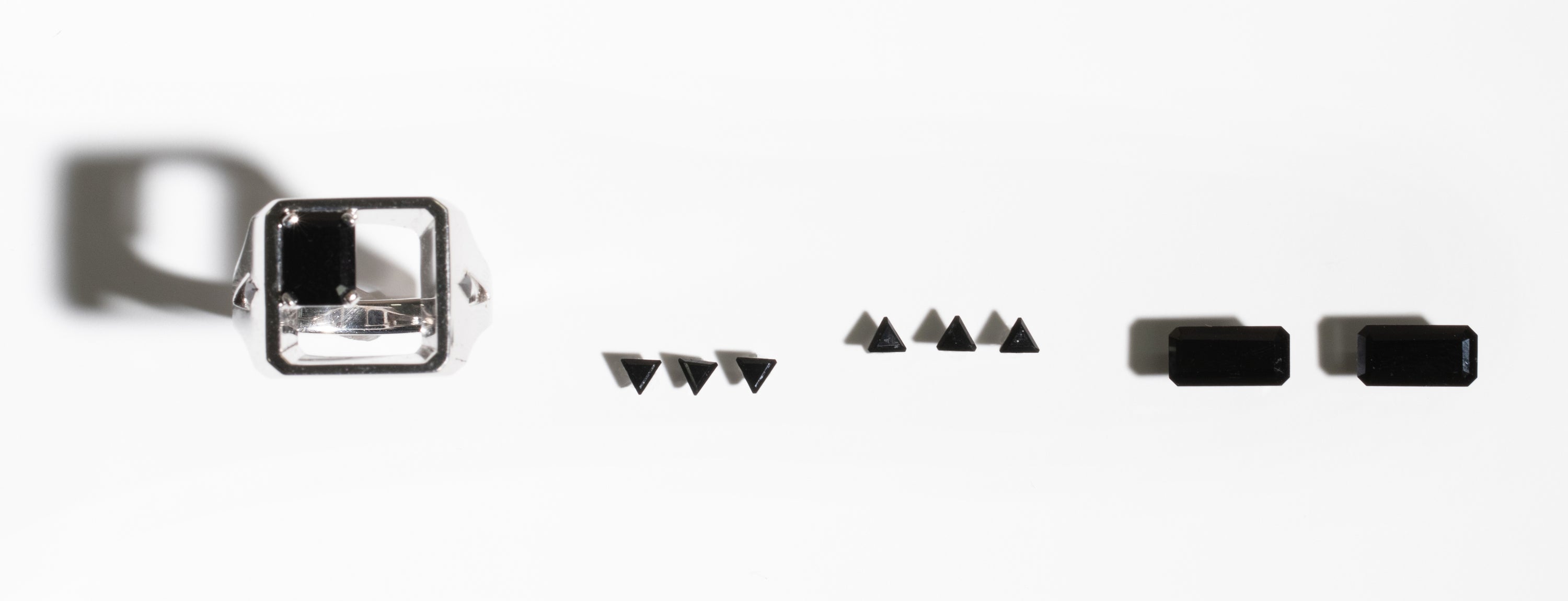
BLACK SPINEL
Known as the ‘impostor gemstone’, spinel has been ‘caught’ in many dramatic places. Most notably, the red gem in London’s Imperial State Crown Jewels, once believed to be a ruby, is in fact a spinel. Natural spinel comes in a variety of colors from red to blue and lavender; we favor working with the opaque black variety.
We began working with spinel in 2016 as an alternative to onyx, which is a heavily treated and dyed stone. Sourced from Australia, our black spinel is custom cut for us in a fair trade factory in Shenzen, China.
For further reading:
The Book of Sacred Stones, Barbara G. Walker
The Book Of Stones: Who They Are and What They Teach, Robert Simmons and Naisha Ahsian
Guide to Gems, Cally Oldershaw
Ruby, Sapphire, & Emerald Buying Guide: How to Identify, Evaluate and Select these Gems, Renee Newman GG